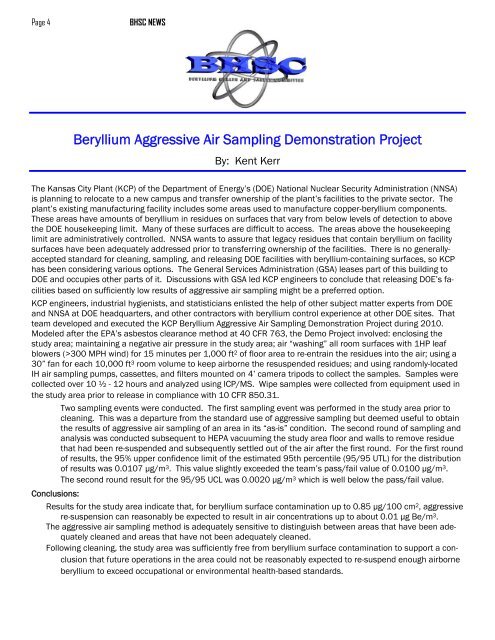information - Beryllium Health & Safety Committee
information - Beryllium Health & Safety Committee
information - Beryllium Health & Safety Committee
You also want an ePaper? Increase the reach of your titles
YUMPU automatically turns print PDFs into web optimized ePapers that Google loves.
Page 4<br />
BHSC NEWS<br />
<strong>Beryllium</strong> Aggressive Air Sampling Demonstration Project<br />
By: Kent Kerr<br />
The Kansas City Plant (KCP) of the Department of Energy’s (DOE) National Nuclear Security Administration (NNSA)<br />
is planning to relocate to a new campus and transfer ownership of the plant’s facilities to the private sector. The<br />
plant’s existing manufacturing facility includes some areas used to manufacture copper-beryllium components.<br />
These areas have amounts of beryllium in residues on surfaces that vary from below levels of detection to above<br />
the DOE housekeeping limit. Many of these surfaces are difficult to access. The areas above the housekeeping<br />
limit are administratively controlled. NNSA wants to assure that legacy residues that contain beryllium on facility<br />
surfaces have been adequately addressed prior to transferring ownership of the facilities. There is no generallyaccepted<br />
standard for cleaning, sampling, and releasing DOE facilities with beryllium-containing surfaces, so KCP<br />
has been considering various options. The General Services Administration (GSA) leases part of this building to<br />
DOE and occupies other parts of it. Discussions with GSA led KCP engineers to conclude that releasing DOE’s facilities<br />
based on sufficiently low results of aggressive air sampling might be a preferred option.<br />
KCP engineers, industrial hygienists, and statisticians enlisted the help of other subject matter experts from DOE<br />
and NNSA at DOE headquarters, and other contractors with beryllium control experience at other DOE sites. That<br />
team developed and executed the KCP <strong>Beryllium</strong> Aggressive Air Sampling Demonstration Project during 2010.<br />
Modeled after the EPA’s asbestos clearance method at 40 CFR 763, the Demo Project involved: enclosing the<br />
study area; maintaining a negative air pressure in the study area; air “washing” all room surfaces with 1HP leaf<br />
blowers (>300 MPH wind) for 15 minutes per 1,000 ft 2 of floor area to re-entrain the residues into the air; using a<br />
30” fan for each 10,000 ft 3 room volume to keep airborne the resuspended residues; and using randomly-located<br />
IH air sampling pumps, cassettes, and filters mounted on 4’ camera tripods to collect the samples. Samples were<br />
collected over 10 ½ - 12 hours and analyzed using ICP/MS. Wipe samples were collected from equipment used in<br />
the study area prior to release in compliance with 10 CFR 850.31.<br />
Two sampling events were conducted. The first sampling event was performed in the study area prior to<br />
cleaning. This was a departure from the standard use of aggressive sampling but deemed useful to obtain<br />
the results of aggressive air sampling of an area in its “as-is” condition. The second round of sampling and<br />
analysis was conducted subsequent to HEPA vacuuming the study area floor and walls to remove residue<br />
that had been re-suspended and subsequently settled out of the air after the first round. For the first round<br />
of results, the 95% upper confidence limit of the estimated 95th percentile (95/95 UTL) for the distribution<br />
of results was 0.0107 µg/m 3 . This value slightly exceeded the team’s pass/fail value of 0.0100 µg/m 3 .<br />
The second round result for the 95/95 UCL was 0.0020 µg/m 3 which is well below the pass/fail value.<br />
Conclusions:<br />
Results for the study area indicate that, for beryllium surface contamination up to 0.85 µg/100 cm 2 , aggressive<br />
re-suspension can reasonably be expected to result in air concentrations up to about 0.01 µg Be/m 3 .<br />
The aggressive air sampling method is adequately sensitive to distinguish between areas that have been adequately<br />
cleaned and areas that have not been adequately cleaned.<br />
Following cleaning, the study area was sufficiently free from beryllium surface contamination to support a conclusion<br />
that future operations in the area could not be reasonably expected to re-suspend enough airborne<br />
beryllium to exceed occupational or environmental health-based standards.
















